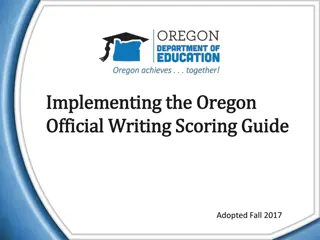Overview of RACP Divisional Clinical Examination Scoring Grid and Bands
This presentation provides an in-depth look at the RACP Divisional Clinical Examination, focusing on its purpose, format, pass/fail criteria, and scoring grid. The exam assesses clinical skills and acumen necessary for Basic Physician Training completion. It includes long and short cases rated on a six-point scale, with performance determining pass/fail results. Guidelines emphasize achieving a minimum standard across cases to compensate for variations in competency. Images illustrate the scoring process to give a comprehensive understanding of the evaluation criteria.
Download Presentation

Please find below an Image/Link to download the presentation.
The content on the website is provided AS IS for your information and personal use only. It may not be sold, licensed, or shared on other websites without obtaining consent from the author. Download presentation by click this link. If you encounter any issues during the download, it is possible that the publisher has removed the file from their server.
E N D
Presentation Transcript
Purpose of this presentation To give you an overview of the RACP Divisional Clinical Examination To explain how the the scoring grid and bands are used. We will talk about: The purpose / format of the clinical examination How pass and fail results are determined The scoring grid and bands
Statement of Purpose of the Clinical Exam The purpose of the RACP Divisional Clinical Examination is to assess the clinical skills, clinical acumen and interpersonal skills to inform whether trainees have reached the standard for completion of Basic Physician Training.
Examination Format The Divisional Clinical Exam consists of: Two (2) Long Cases Focus on history, clinical examination, synthesis and prioritisation of clinical problems, impact on patient/family, appropriate management plan. Four (4) Short Cases Focus on physical examination technique and accuracy, interpretation and synthesis of findings, interaction with patient/family and investigation and management. Real patient situations. Two (2) examiners per case. Each case is rated on a six-point scale (see Purpose and Rubric video on the RACP website). The two examiners mark individually and then come to a consensus score after a discussion.
How are pass and fail results determined? Does the candidate meet the expected standard? Overall performance across the whole exam Combination of candidate s long case scores and short case scores
Divisional Clinical Examination Score Grid Guidelines The Divisional Clinical Examination must be considered as one examination that includes both Long and Short cases. The sufficient differences between competencies assessed in the long and short cases mean that a minimum standard must be achieved in at least one long and one short case. The overlap between competencies assessed means that a weaker performance in one case may be compensated by a stronger performance in another.
Considering Long Cases Long Case #1 Score 1 2 3 4 5 6 Below Standard 1 2 Long Case #2 Score 3 4 5 Above Standard 6
Considering Long Cases Long Case #1 score 3 1 2 4 5 6 Long Case #2 score 1 2 3 4 5 6
Combining performance on short cases and long cases Balance of performance on all cases. When looking at short cases, we need to consider: The number of short cases passed (over 4) Sum of performance (or Aggregate ) on all four short cases. Stronger short case (SC) performance should compensate for weaker long case (LC) performance and vice versa
Divisional Clinical Examination Banded Model Long Case #1 Score 1 2 3 4 5 6 0 0 0 0 1 2 1 0 0 0 1 2 3 2 Long Case #2 Score 0 0 0 2 3 4 3 0 1 2 3 4 4 4 1 2 3 4 4 5 5 2 3 4 4 5 5 6 Band 0: Does not meet Standard Band 1: SC Passed 3 AND SC Aggregate Score 19 Band 2: SC Passed 2 AND SC Aggregate Score 15 Band 3: SC Passed 2 AND SC Aggregate Score 13 0 1 2 3 4 5 Band 4: SC Passed 1 AND SC Aggregate Score 13 Band 5: SC Passed 1 AND SC Aggregate Score 12
Overview Long cases on axes Long Case #1 Score 1 2 3 4 5 6 Diagonal progression of bands differing requirements of short case performance 0 0 0 0 1 2 1 0 0 0 1 2 3 2 Long Case #2 Score Poorer long case performance requires better short case performance 0 0 0 2 3 4 3 0 1 2 3 4 4 4 1 2 3 4 4 5 5 The bands are consistent except for long case scores of 3 and 3 as both long cases have not met the standard (so Band 0, not Band 1) 2 3 4 4 5 5 6 Band 0: Does not meet Standard Band 1: SC Passed 3 AND SC Aggregate Score 19 Band 2: SC Passed 2 AND SC Aggregate Score 15 Band 3: SC Passed 2 AND SC Aggregate Score 13 0 1 2 3 4 5 The bands are symmetrical. For example long case scores of (5 and 2) are identical to (2 and 5) Band 4: SC Passed 1 AND SC Aggregate Score 13 Band 5: SC Passed 1 AND SC Aggregate Score 12
Examples To illustrate how this model works, we have provided a few examples using a 2-step process. Long Case #1 Score 1 2 3 4 5 6 0 0 0 0 1 2 1 0 0 0 1 2 3 2 Long Case #2 Score 0 0 0 2 3 4 Step 1: Determine the Band based on Long Cases 3 0 1 2 3 4 4 4 1 2 3 4 4 5 5 2 3 4 4 5 5 6 Step 2: Apply the Band Rules based on Short Cases Band 0: Does not meet Standard Band 1: SC Passed 3 AND SC Aggregate Score 19 Band 2: SC Passed 2 AND SC Aggregate Score 15 Band 3: SC Passed 2 AND SC Aggregate Score 13 0 1 2 3 4 5 Band 4: SC Passed 1 AND SC Aggregate Score 13 Band 5: SC Passed 1 AND SC Aggregate Score 12
Long Case #1 Score Example 1 1 2 3 4 5 6 0 0 0 0 1 2 1 Long Case Scores Short Case Scores 0 0 0 1 2 3 2 Long Case #2 Score 0 0 0 2 3 4 3 5,5 4,4,4,4 0 1 2 3 4 4 4 1 2 3 4 4 5 5 Step 1: Determine Band Band: 4 2 3 4 4 5 5 6 Band 0: Does not meet Standard Band 1: SC Passed 3 AND SC Aggregate Score 19 Band 2: SC Passed 2 AND SC Aggregate Score 15 Band 3: SC Passed 2 AND SC Aggregate Score 13 0 1 2 3 4 5 Step 2: Apply Band Rules SC Passed: 4 SC Aggregate: 16 Band 4: SC Passed 1 AND SC Aggregate Score 13 Band 5: SC Passed 1 AND SC Aggregate Score 12 Outcome PASS
Long Case #1 Score Example 2 1 2 3 4 5 6 0 0 0 0 1 2 1 Long Case Scores Short Case Scores 0 0 0 1 2 3 2 Long Case #2 Score 0 0 0 2 3 4 3 4,4 4,4,4,4 0 1 2 3 4 4 4 1 2 3 4 4 5 5 Step 1: Determine Band Band: 3 2 3 4 4 5 5 6 Band 0: Does not meet Standard Band 1: SC Passed 3 AND SC Aggregate Score 19 Band 2: SC Passed 2 AND SC Aggregate Score 15 Band 3: SC Passed 2 AND SC Aggregate Score 13 0 1 2 3 4 5 Step 2: Apply Band Rules SC Passed: 4 SC Aggregate: 16 Band 4: SC Passed 1 AND SC Aggregate Score 13 Band 5: SC Passed 1 AND SC Aggregate Score 12 Outcome PASS
Long Case #1 Score Example 3 1 2 3 4 5 6 0 0 0 0 1 2 1 Long Case Scores Short Case Scores 0 0 0 1 2 3 2 Long Case #2 Score 0 0 0 2 3 4 3 4,4 2,4,2,4 0 1 2 3 4 4 4 1 2 3 4 4 5 5 Step 1: Determine Band Band: 3 2 3 4 4 5 5 6 Band 0: Does not meet Standard Band 1: SC Passed 3 AND SC Aggregate Score 19 Band 2: SC Passed 2 AND SC Aggregate Score 15 Band 3: SC Passed 2 AND SC Aggregate Score 13 0 1 2 3 4 5 Step 2: Apply Band Rules SC Passed: 2 SC Aggregate: 12 Band 4: SC Passed 1 AND SC Aggregate Score 13 Band 5: SC Passed 1 AND SC Aggregate Score 12 Outcome FAIL
Long Case #1 Score Example 4 1 2 3 4 5 6 0 0 0 0 1 2 1 Long Case Scores Short Case Scores 0 0 0 1 2 3 2 Long Case #2 Score 0 0 0 2 3 4 3 6,3 3,3,2,4 0 1 2 3 4 4 4 1 2 3 4 4 5 5 Step 1: Determine Band Band: 4 2 3 4 4 5 5 6 Band 0: Does not meet Standard Band 1: SC Passed 3 AND SC Aggregate Score 19 Band 2: SC Passed 2 AND SC Aggregate Score 15 Band 3: SC Passed 2 AND SC Aggregate Score 13 0 1 2 3 4 5 Step 2: Apply Band Rules SC Passed: 1 SC Aggregate: 12 Band 4: SC Passed 1 AND SC Aggregate Score 13 Band 5: SC Passed 1 AND SC Aggregate Score 12 Outcome FAIL
Long Case #1 Score Example 5 1 2 3 4 5 6 0 0 0 0 1 2 1 Long Case Scores Short Case Scores 0 0 0 1 2 3 2 Long Case #2 Score 0 0 0 2 3 4 3 2,4 4,6,5,4 0 1 2 3 4 4 4 1 2 3 4 4 5 5 Step 1: Determine Band Band: 1 2 3 4 4 5 5 6 Band 0: Does not meet Standard Band 1: SC Passed 3 AND SC Aggregate Score 19 Band 2: SC Passed 2 AND SC Aggregate Score 15 Band 3: SC Passed 2 AND SC Aggregate Score 13 0 1 2 3 4 5 Step 2: Apply Band Rules SC Passed: 4 SC Aggregate: 19 Band 4: SC Passed 1 AND SC Aggregate Score 13 Band 5: SC Passed 1 AND SC Aggregate Score 12 Outcome PASS
Long Case #1 Score Example 6 1 2 3 4 5 6 0 0 0 0 1 2 1 Long Case Scores Short Case Scores 0 0 0 1 2 3 2 Long Case #2 Score 0 0 0 2 3 4 3 3,4 4,2,4,6 0 1 2 3 4 4 4 1 2 3 4 4 5 5 Step 1: Determine Band Band: 2 2 3 4 4 5 5 6 Band 0: Does not meet Standard Band 1: SC Passed 3 AND SC Aggregate Score 19 Band 2: SC Passed 2 AND SC Aggregate Score 15 Band 3: SC Passed 2 AND SC Aggregate Score 13 0 1 2 3 4 5 Step 2: Apply Band Rules SC Passed: 3 SC Aggregate: 16 Band 4: SC Passed 1 AND SC Aggregate Score 13 Band 5: SC Passed 1 AND SC Aggregate Score 12 Outcome PASS
More information For more information about the Divisional Clinical Exam and the 2019 rubric see the accompanying video https://www.racp.edu.au/trainees/assessments/exams/d ivisional-clinical-examination/resources The 2019 rubric for the Divisional Clinical Examinations in Adult Medicine and Paediatrics & Child Health can be downloaded at: https://www.racp.edu.au/trainees/assessments/exams/d ivisional-clinical-examination/resources























